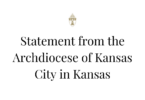Baptism brings first priest to Valley Falls more than 150 years ago
by Joe Bollig
joe.bollig@theleaven.org
VALLEY FALLS — Church cornerstones don’t lie, but they don’t tell the whole story.
Take, for example, the cornerstone of Immaculate Conception Church in Valley Falls. It dates the founding of the parish as 1859. Fair enough, because that’s what the official records say.
One could say, however, that the birth of the parish actually began with the first settler birth, to a Catholic family, in then-named Grasshopper Falls about June 1, 1857.
“The wind blew violently, the lightning flashed, the thunder roared, and the rain poured down in torrents, and ran into the tent, wetting the occupants. The next morning all hands drank to the health of the new-born child,” according to “History of the State of Kansas” by William G. Cutler.
The birth of Johnnie Considine brought Father Augustine Wirth, OSB, from St. Benedict’s Abbey in Atchison to Grasshopper Falls in September 1857 to perform the first baptism in that area.
A short two years later, the parish was founded.
This first baptism and other historic parish events were commemorated at a 150th anniversary Mass celebrated Dec. 6 by Archbishop Joseph F. Naumann, who was also the homilist. The Mass was concelebrated by Father John Reynolds, who has been pastor there for four years; Abbot Barnabas Senecal, OSB, from St. Benedict’s Abbey; and former pastor Father Thomas Cawley, CM.
A dinner was held in the parish hall following the Mass, and, in keeping with parish tradition, “St. Nicholas” visited the parish youth. A commemorative 150th anniversary history book, written by Lesa Brose, was on sale for parishioners, and parish artifacts — like Latin altar cards and a Latin Sacramentary — were on display.
The anniversary was also an occasion to celebrate another tremendous milestone — the blessing of newly installed stained-glass windows.
“We just got the last [of 10] windows installed on Nov. 21,” said Larry Heinen, parish council chairman.
When the current red brick church was built in 1925, the parish didn’t have enough funds to buy all the windows. “They put in quarter-inch plate glass,” he said. “My understanding was that a fund was actually started, but when the Great Depression hit, they gave the money back to whoever donated, because everyone was pretty much broke.”
Sometime during the 1960s, colored plastic panels were installed in the main windows. A decision was made just a few years ago to finally install stained glass.
The Tobias Studio in St. Joseph, Mo., was given the commission. However, because the shop is small, the windows were produced one at a time.
The total cost was approximately $162,000 — paid for by donations, memorials and sponsorships.
“Families [that contributed] have their names in the windows,” said Heinen. “One woman, who died in the late 1950s, donated her farm to the parish and said in her will that when such time [came that] the parish installed stained-glass windows, to dedicate one to [her family].”
The windows themselves — which Archbishop Naumann blessed during the Mass — may have made history. Five of the windows depict the glorious mysteries of the rosary, and the other five depict the luminous mysteries.
“We believe we’re the first parish, at least in Kansas, to have the luminous mysteries in stained glass,” said Father Reynolds.
St. Mary’s Immaculate Conception Parish has 108 families and is a mission of St. Joseph Parish in Nortonville.
The parish is equidistant from Topeka, Lawrence and Leavenworth, said Larry Martin, chairman of the finance committee. And although it faces the same challenges as other small, rural parishes, it is currently enjoying a period of growth.
Milestones
• 1854: The first settler in Valley Falls (then Grasshopper Falls) was Henry Zen (Senn), a Catholic.
• 1857: The first birth was that of Johnnie Considine, who was born in June and baptized in September by Father Augustine Wirth, OSB, of St. Benedict’s Abbey, Atchison.
• 1859: Some sources say the parish was organized shortly after Considine’s baptism. Other sources record 1858, but the official history says 1859. Mass was celebrated in people’s homes by a circuitriding priest.
• 1872: The community stabilized with the arrival of the railroad, and the first brick church was built. Mass was celebrated once a month. The parish had 28 families when the church was built, but only 10 or 12 by 1898.
• 1899: Mass was celebrated twice a month. The parish grew from 15 to 40 families in the next few years.
• 1904: A parish school was founded and a house was bought for the first teachers, two Benedictine Sisters from Atchison.
• 1907: A new, cement block church was built to accommodate the growing membership.
• 1909: The parish received its first resident pastor. A parish house was bought and a cemetery was established.
• 1924: The church and school were destroyed by a fire that many believed was set by the local Ku Klux Klan, which had become very active.
• 1925: Construction began on a new, brick church. The basement was used for Mass and baptisms by 1926, and the church was dedicated on Thanksgiving Day, Nov. 25, 1926. Parishioners had done much of the site preparation and other work.
• 1925-1952: The parish slowly paid off the debt from building the new church. Finances were difficult all through the Great Depression of the 1930s and the war years of the 1940s.
• 1953: The 1950s saw a growth in population and good economic conditions.
• 1961: The parish was raising money to build a new school when it was informed that the Benedictine Sisters did not have Sisters available to teach. The school closed during the 1967-1968 school year with 60 students. Improvements were made over the decade to the school, which was used for religious education.
• 2009: The parish celebrated its 150th anniversary and the completion of the stained-glass windows project.






